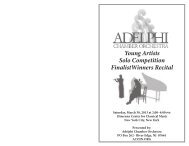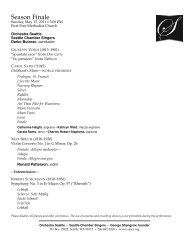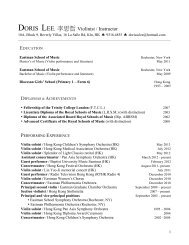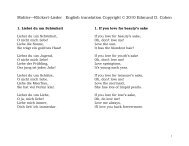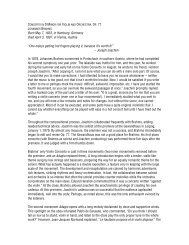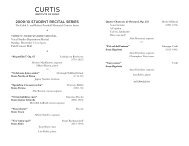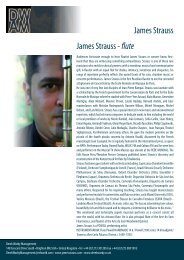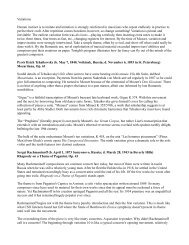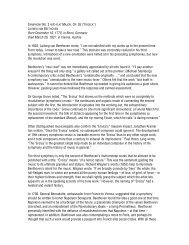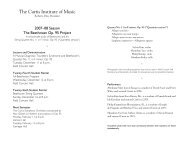Coriolan Overture, opus 62 Ludwig van Beethoven ... - InstantEncore
Coriolan Overture, opus 62 Ludwig van Beethoven ... - InstantEncore
Coriolan Overture, opus 62 Ludwig van Beethoven ... - InstantEncore
Create successful ePaper yourself
Turn your PDF publications into a flip-book with our unique Google optimized e-Paper software.
<strong>Coriolan</strong> <strong>Overture</strong>, <strong>opus</strong> <strong>62</strong><br />
<strong>Ludwig</strong> <strong>van</strong> <strong>Beethoven</strong><br />
(b. 1770, Bonn, Germany; d. 1827, Vienna Austria)<br />
One of Shakespeare's most powerful tragedies is <strong>Coriolan</strong>us, the story (drawn from<br />
Plutarch's Lives) of a patrician Roman general destroyed by his overweening pride. After<br />
a decisive victory over the Volscians, <strong>Coriolan</strong>us refuses the consulship of Rome because<br />
it requires him to humble himself before the plebians or commoners; enraged at his<br />
arrogance, the people drive him into exile. But the willful general seeks revenge: he<br />
defects to his former enemies, the Volscians, and leads them against Rome. He battles his<br />
way to the very gates of Rome, where his compatriots send delegation after delegation<br />
asking him to spare his own city. When the stiff-necked warrior remains obdurate, his<br />
wife, mother, and son go out to plead with him, and he finally relents. Furious at his<br />
betrayal, the Volscians put him to death.<br />
Although <strong>Beethoven</strong> considered himself a republican and the foe of tyrants, he<br />
must have found many points in common between himself and this haughty Roman. He,<br />
too, possessed an iron will and, convinced of his genius, would not bend his neck even to<br />
princes. And he had practical reasons for creating an overture on this subject. In 1807, the<br />
composer was currying favor with the Viennese poet-playwright Heinrich von Collin,<br />
who was influential at Vienna's Imperial Theatre and who had written his own version of<br />
the <strong>Coriolan</strong>us tragedy five years earlier. Seeking a steady source of income, <strong>Beethoven</strong><br />
wanted to secure a contract with the Theatre to write an opera annually for production<br />
there; he also hoped Collin would collaborate as his librettist. Though neither of these<br />
goals was realized, one of <strong>Beethoven</strong>'s greatest overtures, the tensely dramatic <strong>Coriolan</strong>,<br />
was born. It introduced Collin's play at a performance on April 24, 1807.<br />
A taut sonata form, the <strong>Coriolan</strong> <strong>Overture</strong> musically describes the full tragedy in<br />
just eight minutes. It is cast in a significant key for <strong>Beethoven</strong>: C minor, which Michael<br />
Steinberg calls his “clenched-fist” key; it also colored other heroic works, notably his<br />
Fifth Symphony. Three massive C's exploding into violent chords open the piece; they<br />
are separated by dramatic pauses, which will be an important element throughout. Here is<br />
a titanic yet concise portrait of a hero ruled by will and rage. <strong>Coriolan</strong>us' restless<br />
temperament is further delineated by the fitful, ever-modulating principal theme that<br />
follows. In utter contrast is the lovely, flowing second theme, representing the feminine<br />
pleas of the warrior's wife and mother. When the massive C's return for the third and final<br />
time, <strong>Beethoven</strong> foretells the hero's fate. <strong>Coriolan</strong>us' music suddenly disintegrates into<br />
the silence of death, ending with three almost inaudible plucked C's.<br />
Introduction and Rondo capriccioso, <strong>opus</strong> 28<br />
Camille Saint-Saëns<br />
(b. 1835, Paris, France; d. 1921, Algiers, Algeria)<br />
Over the course of his long (he lived to be 86) and prolific life, Camille Saint-Saëns<br />
became the dominant figure in French music during the late Romantic age and developed<br />
a conservative style and taste that made success harder for his more progressive<br />
colleagues. But when he composed his Introduction and Rondo capriccioso for violin and<br />
orchestra in 1863, he was only 27 and still struggling to win his own place in Parisian
concert life. Interestingly, his friend and fellow striver then was Georges Bizet; the two<br />
young composers cheered each other on, and Bizet even made a piano transcription of the<br />
Introduction and Rondo to sell to non-virtuosos playing at home.<br />
The extraordinary young Spanish violinist Pablo de Sarasate was another friend<br />
of Saint-Saëns, and his special qualities as a virtuoso shaped the way the composer would<br />
write for this instrument. Sarasate’s tone was not large, but it was pure and brilliant, and<br />
his intonation was unerring. None other than George Bernard Shaw (a music critic in his<br />
early career) described him bluntly: “He never interprets anything: he plays it beautifully,<br />
and that is all. He is always alert, swift, clear, refined, certain, scrupulously attentive, and<br />
quite unaffected.”<br />
Therefore, in composing the Introduction and Rondo for him, Saint-Saëns<br />
emphasized clarity of sound and de-emphasized the orchestral part to allow the violinist’s<br />
smallish tone to dominate. He also concocted melodies and rhythms with a slightly<br />
Spanish flavor to salute the violinist’s homeland. Years later as their friendship<br />
continued, Saint-Saëns created a full-length concerto for the Spaniard: the sumptuously<br />
beautiful Third Violin Concerto.<br />
Not initially a success with French audiences, the Introduction and Rondo has<br />
now become one of the most beloved of all virtuoso violin showpieces. Scholar Michael<br />
Stegemann suggests that it is actually an instrumental adaptation of the standard formula<br />
for a French operatic aria in the middle 19 th century: a slow-tempo arioso or recitative<br />
followed by a fast brilliant aria. In a slow introductory section, the violinist unfurls a<br />
soulful melody in A minor. Then the music snaps into a lively Allegro for the rondo<br />
itself. Linked together by the puckish rondo theme that the soloist introduces at the<br />
beginning, it boasts a variety of infectiously tuneful episodes, some suggesting Spanish<br />
dance, others exploiting the violin’s capacity for tender, heart-on-sleeve singing. The<br />
faster closing coda finally carries the music into the brighter key of A major.<br />
Zigeunerweisen (Gypsy Airs)<br />
Pablo de Sarasate<br />
(b. 1844, Pamplona, Spain; d. 1908, Biarritz, France)<br />
The legendary Spanish violin virtuoso Pable de Sarasate composed Zigeunerweisen, one<br />
of the most popular of all violin showpieces, to display his own unsurpassed mastery of<br />
the instrument. His prodigious talent revealed itself early, and at age 12, he was sent to<br />
Paris, with the assistance of Spain's Queen Isabella, to study at the Conservatoire. He<br />
became renowned for the elegance of his playing and the beauty of his tone. Violinist<br />
Leopold Auer described it as “a tone of supreme singing quality,” while the conductor<br />
Hans von Bülow remembered his “seductive speaking on the violin.” His intonation was<br />
considered perfect, and his ease in all registers of the violin — but especially in its<br />
hazardous upper reaches — miraculous.<br />
Not content with being a traveling virtuoso, Sarasate also turned his hand to<br />
composing. Today he is best known for his Carmen Fantasy, based on themes from<br />
Bizet's opera, and for Zigeunerweisen or "Gypsy Airs" (1878). Unlike the Carmen<br />
Fantasy, there is nothing Spanish about the gypsy music evoked in Zigeunerweisen;<br />
rather, as its German title suggests, it celebrates the gypsy-violin tradition of Eastern<br />
Europe, in the manner of Liszt's and Brahms Hungarian rhapsodies.
Following a brief introduction, the music unfolds in two contrasting sections. The<br />
first is slow and smoldering in temperament. Over a dragging 4/4 beat, the violinist<br />
delivers elaborately embellished melodies featuring big melodic skips and many passages<br />
at the extreme top of the range to show off Sarasate's own remarkable technique. Finally,<br />
these embers blaze forth in a gypsy dance of high-speed pyrotechnics that tests the<br />
player's agility and accuracy to the max.<br />
Symphony No. 7 in A Major, <strong>opus</strong> 92<br />
<strong>Ludwig</strong> <strong>van</strong> <strong>Beethoven</strong><br />
<strong>Beethoven</strong>'s Seventh Symphony is one of the most extraordinary expressions of physical<br />
energy and joy in symphonic music. Completed in 1812, the Seventh, in the words of<br />
<strong>Beethoven</strong> biographer Maynard Solomon, “transports us into a sphere of laughter, play,<br />
and the exuberant release of bound energy.” This is a work without a shadow or a solemn<br />
thought or even a true slow movement — its well-loved Allegretto second movement<br />
only seems slow in comparison to its hyperkinetic companions. In any other hands, such<br />
unrelieved happiness might produce a feeling of triviality or monotony, but <strong>Beethoven</strong><br />
instead shows us the dynamic variety of joy.<br />
In an oft-quoted aphorism, composer Richard Wagner called the Seventh “the<br />
apotheosis of the dance,” a phrase more impressive than illuminating, for no movement<br />
here could be construed as a dance, except in the most abstract sense. More accurately,<br />
we might call this symphony “the apotheosis of rhythm.” Throughout <strong>Beethoven</strong>'s music,<br />
themes are as much characterized by their rhythmic patterns as by their melodic shapes or<br />
harmonic coloring. Here rhythm is the prime building block: the first, second, and fourth<br />
movements are all generated by one obsessive rhythmic figure announced at the opening;<br />
the third-movement scherzo has two such figures. <strong>Beethoven</strong> wields these rhythms with a<br />
display of unbridled energy and exuberance that shocked many of the Seventh's first<br />
listeners. Hearing the work at an early performance in conservative Leipzig, Friedrich<br />
Wieck, father of Clara Schumann, stated that <strong>Beethoven</strong> must have written it “in a<br />
drunken fury”!<br />
The Seventh was introduced to the world at a spectacular celebrity-studded<br />
concert on December 8, 1813 at the University of Vienna that was the most successful of<br />
<strong>Beethoven</strong>'s career. Organized by <strong>Beethoven</strong>'s friend Johann Nepomuk Maelzel, the<br />
inventor of the metronome, it was a benefit concert to raise money for soldiers wounded<br />
at the recent Napoleonic battle of Hanau. Both performers and audience were in high<br />
spirits for by this time it was clear that Napoleon's days were numbered. For the<br />
occasion, <strong>Beethoven</strong> had written one of his most notorious compositions, Wellington's<br />
Victory: a military extravaganza calling for vast troops of musicians and a huge<br />
percussion battery, manned by such luminaries as opera composer Giacomo Meyerbeer<br />
and piano virtuoso Ignaz Moscheles. In one of his last appearances as a conductor,<br />
<strong>Beethoven</strong> led the proceedings, but his deafness severely hampered his effectiveness. It is<br />
amazing the Seventh Symphony was even noticed in this circus atmosphere, but indeed it<br />
was warmly received and the audience demanded an encore of the second movement.<br />
The first movement begins with a slow introduction — the biggest <strong>Beethoven</strong><br />
ever wrote. Its expansive dimensions, accentuated by majestic rising scales, allows for<br />
two lyrical interludes — led first by oboes, then by the flute — which carry the music to
keys remote from the A-major home base. It is linked to the main Vivace section by the<br />
playful evolution of the galloping dotted rhythm that drives the rest of the movement.<br />
Late in its course, listen for the remarkable passage in which the low strings mutter a<br />
twisting dissonant motive — like an evil worm corrupting the tranquil, sustained<br />
harmony above.<br />
Another persistent rhythmic pattern propels the beloved second movement: a<br />
gentle march beat of long-short-short-long-long. <strong>Beethoven</strong> lets its wonderful theme<br />
gradually unfurl: first the bare-bones tune in low strings, then the stately march melody<br />
above, accompanied by graceful countermelodies. The form is one of <strong>Beethoven</strong>'s own<br />
devising: part rondo, part theme-and-variations. And in a later return of the march theme,<br />
it evolves into a cunning fugue as well.<br />
Movement three is <strong>Beethoven</strong>'s most ebullient and propulsive scherzo, powered<br />
by the relentless chugging of quarter notes in a frenzied Presto tempo. Providing utmost<br />
contrast, the trio section, dominated by woodwinds, is smoothly lyrical over a sustained<br />
pedal note. In a favorite trick, also used in his Fourth Symphony, <strong>Beethoven</strong> runs around<br />
the scherzo-trio track three times, though as the trio begins it third reprise, it falters<br />
harmonically and is roughly dismissed.<br />
The finale is a fierce dance of triumph. Again a rhythmic motive starts the action:<br />
a cannon-boom followed by a three-note rat-ta-tat rifle response. This wild and surging<br />
music has a pronounced military flavor suited to its era. In fact, we hear a theme of<br />
swaggering martial gait early on, and in the coda the trumpets carry it to a ringing<br />
affirmation. Here, <strong>Beethoven</strong> joyfully trounces Napoleon and all the enemies of<br />
humankind.<br />
Notes by Janet E. Bedell copyright 2009



